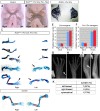Tbx5 Buffers Inherent Left/Right Asymmetry Ensuring Symmetric Forelimb Formation
- PMID: 27992425
- PMCID: PMC5215935
- DOI: 10.1371/journal.pgen.1006521
Tbx5 Buffers Inherent Left/Right Asymmetry Ensuring Symmetric Forelimb Formation
Abstract
The forelimbs and hindlimbs of vertebrates are bilaterally symmetric. The mechanisms that ensure symmetric limb formation are unknown but they can be disrupted in disease. In Holt-Oram Syndrome (HOS), caused by mutations in TBX5, affected individuals have left-biased upper/forelimb defects. We demonstrate a role for the transcription factor Tbx5 in ensuring the symmetric formation of the left and right forelimb. In our mouse model, bilateral hypomorphic levels of Tbx5 produces asymmetric forelimb defects that are consistently more severe in the left limb than the right, phenocopying the left-biased limb defects seen in HOS patients. In Tbx hypomorphic mutants maintained on an INV mutant background, with situs inversus, the laterality of defects is reversed. Our data demonstrate an early, inherent asymmetry in the left and right limb-forming regions and that threshold levels of Tbx5 are required to overcome this asymmetry to ensure symmetric forelimb formation.
Conflict of interest statement
The authors have declared that no competing interests exist.
Figures







Similar articles
-
Tbx5 inhibits hedgehog signaling in determination of digit identity.Hum Mol Genet. 2020 Jun 3;29(9):1405-1416. doi: 10.1093/hmg/ddz185. Hum Mol Genet. 2020. PMID: 31373354 Free PMC article.
-
Functional analysis of two novel TBX5 variants present in individuals with Holt-Oram syndrome with different clinical manifestations.Mol Genet Genomics. 2021 Jul;296(4):809-821. doi: 10.1007/s00438-021-01781-2. Epub 2021 Apr 17. Mol Genet Genomics. 2021. PMID: 33866394
-
MicroRNA 19a replacement partially rescues fin and cardiac defects in zebrafish model of Holt Oram syndrome.Sci Rep. 2015 Dec 14;5:18240. doi: 10.1038/srep18240. Sci Rep. 2015. PMID: 26657204 Free PMC article.
-
Molecular basis of the clinical features of Holt-Oram syndrome resulting from missense and extended protein mutations of the TBX5 gene as well as TBX5 intragenic duplications.Gene. 2015 Apr 15;560(2):129-36. doi: 10.1016/j.gene.2015.02.017. Epub 2015 Feb 11. Gene. 2015. PMID: 25680289 Review.
-
Congenital heart diseases and their association with the variant distribution features on susceptibility genes.Clin Genet. 2017 Mar;91(3):349-354. doi: 10.1111/cge.12835. Epub 2016 Sep 5. Clin Genet. 2017. PMID: 27426723 Review.
Cited by
-
The transcription factor Tbx5 regulates direction-selective retinal ganglion cell development and image stabilization.Curr Biol. 2022 Oct 10;32(19):4286-4298.e5. doi: 10.1016/j.cub.2022.07.064. Epub 2022 Aug 22. Curr Biol. 2022. PMID: 35998637 Free PMC article.
-
Clinical Features and Natural Progression of Unilateral High Myopia in Adults: A Comparison Study.Ophthalmol Sci. 2025 Apr 1;5(5):100780. doi: 10.1016/j.xops.2025.100780. eCollection 2025 Sep-Oct. Ophthalmol Sci. 2025. PMID: 40458669 Free PMC article.
-
Mesoderm patterning by a dynamic gradient of retinoic acid signalling.Philos Trans R Soc Lond B Biol Sci. 2020 Oct 12;375(1809):20190556. doi: 10.1098/rstb.2019.0556. Epub 2020 Aug 24. Philos Trans R Soc Lond B Biol Sci. 2020. PMID: 32829679 Free PMC article. Review.
-
Sprouty2/4 deficiency disrupts early signaling centers impacting chondrogenesis in the mouse forelimb.JBMR Plus. 2025 Jan 10;9(3):ziaf002. doi: 10.1093/jbmrpl/ziaf002. eCollection 2025 Mar. JBMR Plus. 2025. PMID: 39906257 Free PMC article.
-
Anterior lateral plate mesoderm gives rise to multiple tissues and requires tbx5a function in left-right asymmetry, migration dynamics, and cell specification of late-addition cardiac cells.Dev Biol. 2021 Apr;472:52-66. doi: 10.1016/j.ydbio.2021.01.007. Epub 2021 Jan 19. Dev Biol. 2021. PMID: 33482174 Free PMC article.
References
-
- Summerbell D, Wolpert L (1973) Precision of development in chick limb morphogenesis. Nature 244: 228–230. - PubMed
-
- Barnett P, Postma A (2014) Molecular Genetics of Holt–Oram Syndrome eLS.
-
- Rallis C, Bruneau BG, Del Buono J, Seidman CE, Seidman JG, et al. (2003) Tbx5 is required for forelimb bud formation and continued outgrowth. Development 130: 2741–2751. - PubMed
MeSH terms
Substances
Supplementary concepts
Grants and funding
LinkOut - more resources
Full Text Sources
Other Literature Sources
Molecular Biology Databases

